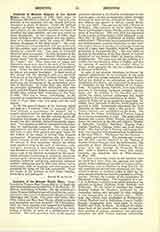

Institute of the Blessed Virgin Mary, IRISH, founded by Mother Frances Mary Teresa Ball (q.v.), under the direction and episcopal jurisdiction of the Most Rev. D. Murray, Archbishop of Dublin. By the archbishop’s desire, Frances Ball had prepared herself for this undertaking by a two years’ novitiate in St. Mary’s Convent, Micklegate Bar, York. Two other Irish ladies, Miss Ellen Arthur and Miss Anne Therry, offered to join the new foundation and were accepted. On November 4, 1822, the three pioneers took possession of Rathfarnham Abbey, which had been purchased by the Archbishop of Dublin to serve as a mother-house and novitiate. The wide-spreading fame of the superior education afforded in the Dublin Archdiocese by the Loretto nuns—as they are commonly called—brought demands for their services throughout Ireland. The first offshoot was planted in Navan, County Meath, in the year 1833. This convent has now a filiation in Mullingar. The convents in North Great George’s Street and Stephen’s Green, Dublin, come next in the order of foundations. The year 1836 was signalized by the rescript of Pope Gregory XVI addressed to the Most Rev. D. Murray, Archbishop of Dublin, which ordained that: “Those who have associated themselves and shall hereafter associate themselves to this institute cannot depart to another, even though observing rules of a more rigid discipline without the express permission of the Apostolic See.” The year 1840 was marked by the erection of the first church in Ireland dedicated to the Sacred Heart, in Loretto Abbey, Rathfarnham. The same year saw the building of a smaller, but very beautiful, abbey in Dalkey, and also the opening of negotiations for another abbey in Gorey, which prepared the way for a future Loretto in the town of Wexford.
In spite of her prudent reluctance to favor the repeated applications for an extension of the Irish sisters’ work into foreign countries, Reverend Mother Ball at last yielded to the solicitations of Dr. Carew, Archbishop of Calcutta, and sanctioned the departure of volunteers for the Indian mission on August 23, 1841. To Loretto House, Calcutta, have been added convents in Darjeeling, Lucknow, Assansol, Intally, Simla, etc. In addition to the boarding and day schools the sisters conduct orphanages and attend diligently to the religious instruction of adults. The success in India led to an appeal for nuns from Dr. Collier, Vicar Apostolic of Madras, which appeal was granted in 1846. Immediately afterwards the Vicar Apostolic of Gibraltar urged a like petition. Two Loretto convents are established on the Rock. The Most Rev. Dr. Power, Archbishop of Toronto, begged for a Loretto community in 1847. The undernamed filiations own Loretto Abbey, Toronto, as their head-house: the convents in the city and suburbs, likewise in Belleville, Lyndsay, Hamilton, Niagara Falls, Guelph, Stratford, Chicago, Joliet, and Sault Sainte Marie. The foundations in Fermoy and Omagh (Ireland) were supplied with members from Rathfarnham in the years 1853-5. The former has two filiationsat Youghal and Clonmel. The Letterkenny Loretto was the first convent founded in the Diocese of Raphoe, County Donegal, since the Reformation. The convents at Bray, Baymount, Kilkenny, and Killarney were also founded by Reverend Mother Ball. After a lingering illness, borne with saintly fortitude, the foundress died on Whit-Sunday, May 19, 1861.
The most noteworthy events in the institute since her death have been: First, the approval and confirmation of the constitutions peculiar to Loretto Abbey, Rathfarnham, and its filiations by Pope Pius IX, the said constitutions having been sanctioned and transmitted to Rome by Cardinal Cullen in 1861, for the usual examination by the Sacred Congregation of Propaganda. Second, the transfer of the community at Baymount to Balbriggan. The foundation of a convent in Ballarat, Australia, from which proceeded the convents at Sydney, Portland, Perth, Adelaide, and Melbourne. To the latter is attached the Central Training College for Teachers, instituted by the Australian bishops and intrusted by their lordships to the management of the Loretto nuns. Third: large day schools were established in Enniscorthy, County Wexford, and in Rathmines, County Dublin. Fourth: foundations have been made in Seville, Madrid, and Yalla, in Spain. In Ireland the educational work of the Loretto nuns ranges through the three systems of primary, secondary, and university education—the girls’ various successes culminating in the winning of studentships and examinerships in the gift of the Royal University of Ireland. In other countries the Loretto nuns invariably work up to the requisite standard fixed by the extern educational authorities. (See .)
SISTER MARY GERTRUDE

